Opposed by beachfront homeowners, more dunes might have shielded LBI from Sandy
-
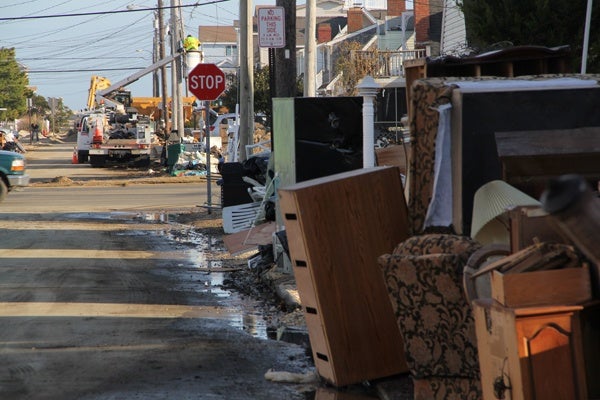
<p>Displaced and discarded appliances and furniture are piled at the curb at Sand Dune Lane and Long Beach Boulevard in Long beach, N.J. (Emma Lee/for NewsWorks)</p>
-
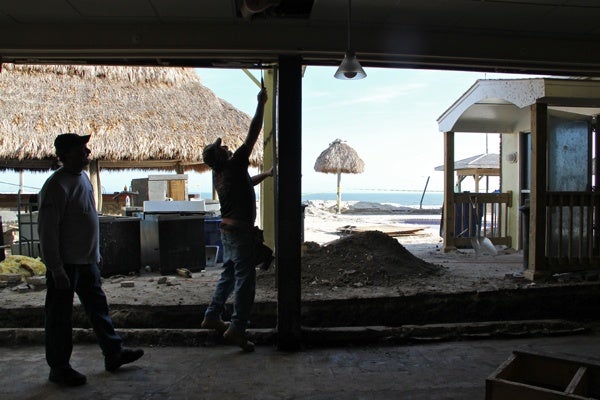
<p>Workers clean up the damaged Sea Shell Resort and Beach Club in Beach Haven, N.J. The club's owner said he objected to dune building because it spoiled the view. (Emma Lee/for NewsWorks)</p>
-
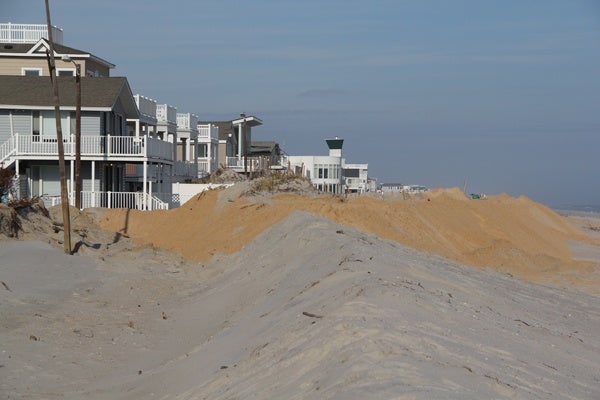
<p>Homes from 31st Street to 57th Street, protected by dunes from a beach replenishment project, survived relatively unscathed, according to the Long Beach mayor. (Emma Lee/for NewsWorks)</p>
-
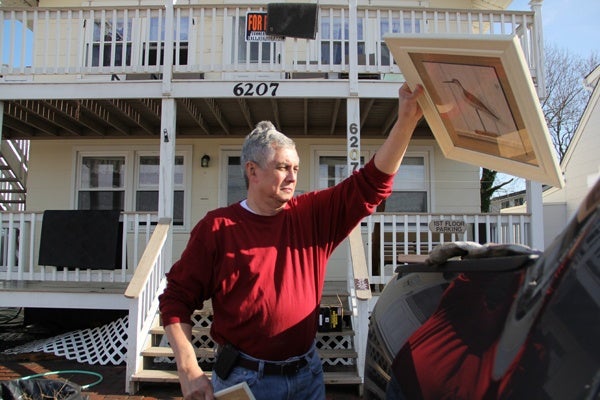
<p>Vince Contreras piles salvaged belongings into his pick-up truck at his beach home on Long Beach Boulevard in Long Beach, N.J. (Emma Lee/for NewsWorks)</p>
-
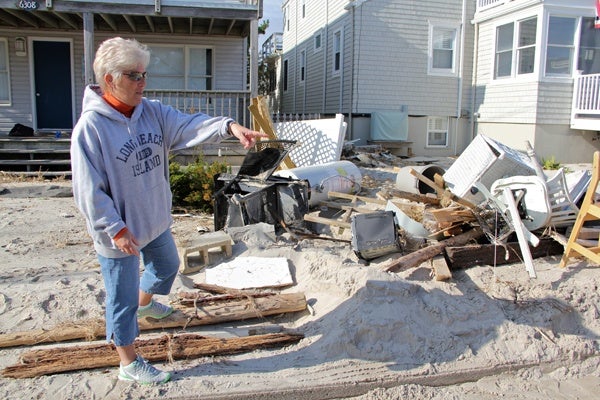
<p>Debbie Gutzler sorts through the debris deposited in the front yard of her home on Atlantic Avenue in Beach Haven, N.J. She suspects that much of it came from her neighbor's beach-front home. (Emma Lee/for NewsWorks)</p>
-
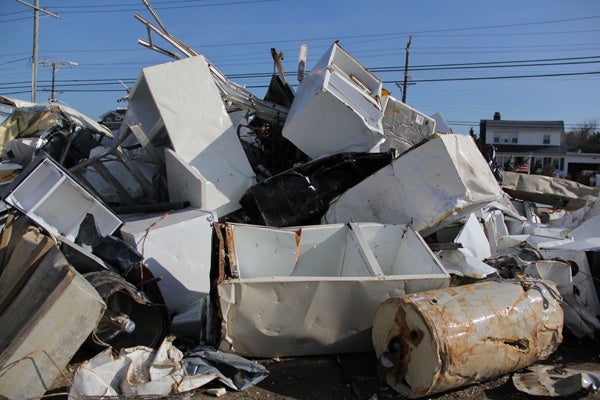
<p>Appliances set adrift by Sandy are piled in the Acme parking lot on Long Beach Boulevard in Beach Haven, N.J. (Emma Lee/for NewsWorks)</p>
-
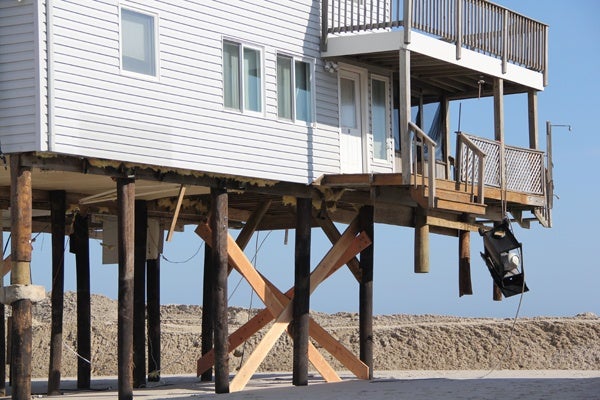
<p>A gas grill dangles from the remains of a porch on a beach-front home on Bay Avenue in Holgate, N.J. (Emma Lee/for NewsWorks)</p>
-
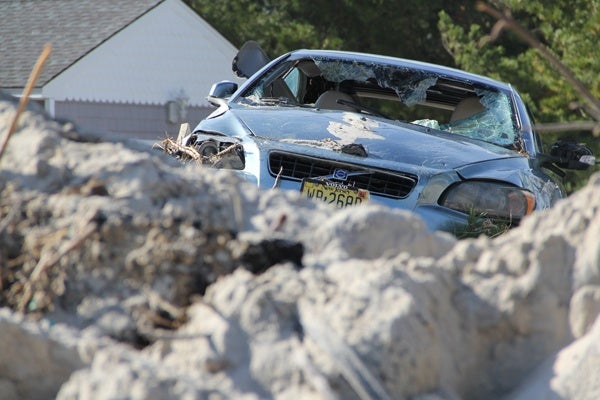
<p>A storm-battered car sits atop a pile of sand in a front yard on Bay Avenue in Holgate, N.J., the area of Long Beach Island hardest hit by Sandy. (Emma Lee/for NewsWorks)</p>
-

<p>Long Beach Mayor Joseph Mancini directs clean-up operations from town hall. He says he will call every beach-front property owner to persuade them to sign an easement allowing beach replenishment. (Emma Lee/for NewsWorks)</p>
-
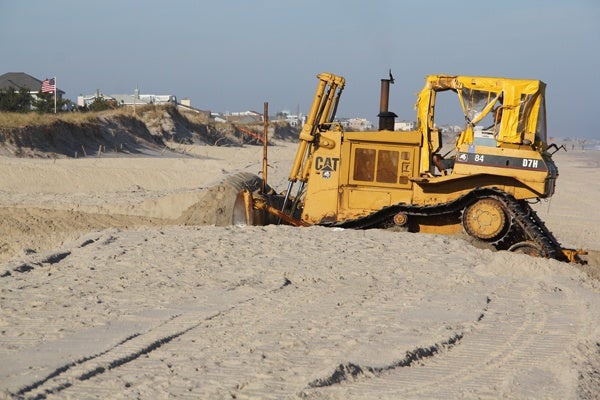
A bulldozer on Long Beach Island moves sand to restore the dunes that were swept away by Hurricane Sandy. (Emma Lee/for NewsWorks)
Superstorm Sandy’s wrath was particularly destructive to New Jersey’s Long Beach Island. The 18-mile barrier island is essentially a half-mile wide strip of land between the Atlantic Ocean and various inland harbors.
On some parts of the island, residents still aren’t allowed to return to their destroyed properties.
Yet, many believe such damage could have been prevented.
Walk south along Ocean Boulevard in the Long Beach Island neighborhood of Brant Beach and you’ll see a stark change. From 31st Street to 57th Street, the houses on both sides of the road seem fine, as if Sandy never had never hit.
Crossing 57th Street south, the sight changes. Beachfront homes have been ravaged. First floors have been completely decimated. Waterlogged debris has been scattered across people’s driveways. Why the difference?
One stretch of the neighborhood recently had a 22-foot-high dune built along the beach. The other side didn’t.
“If you look at the house that’s actually across the street from my house, there’s nothing, the garage is blown out,” said Debbie Gutzler of Tinton Falls. “I would assume that what’s sitting in front of my house is from their house, the hot water tank — I’m not exactly sure.”
Gutzler’s LBI vacation home is going to need new flooring, new pipes and a bit of a landscaping makeover.
“You know I’ve got somebody’s interior door in my backyard over there. So, I would imagine that’s my responsibility,” she said
Plans for island-long dune
In the year 2000, a federally backed project authorized the U.S. Army Corps of Engineers to determine how to best protect the barrier island. By 2005, the corps had a plan to build a dune stretching the length of LBI from Harvey Cedars in the north to Holgate in the south.
As of Superstorm Sandy, only three sections of that stretch were completed: Harvey Cedars, Surf City and a bit of Brant Beach.
“In those three areas there was no oceanfront damage at all to any of the homes,” said Long Beach Township Mayor Joseph Mancini. “A little bit of wind but nothing like the rest of the island.”
The holdup, Mancini says, was beachfront homeowners who refused to allow the corps to construct dunes in front of their property. They said it would ruin their view.
“I hate greed. Neighbors are neighbors. If you’re lucky enough to own an oceanfront, why jeopardize your neighbors’ properties when your belongings are going to end up on their property — or through their property?” said Mancini.
“And that’s what happened here — cars, boats, refrigerators from the oceanfront homes ended up in other peoples’ living rooms.”
This battle has been raging on the island for years — townships asking beachfront property owners to sign easements green-lighting building larger dunes, property owners holding back, hoping the township would offer them a better deal.
In Harvey Cedars, where damage is now minimal, the mayor went ahead with the project even though about a dozen beachfront property owners didn’t sign the easements.
The dispute has gone through the New Jersey legal system, where courts have consistently sided with the homeowners.
Compensation for obstructing views
Essentially the legal argument goes like this: Since dunes are a benefit to the entire community, it’s not fair to ask beachfront homeowners to diminish their views without providing proper compensation.
In one case that’s being appealed in the New Jersey Supreme Court, a couple whose house was protected from Sandy by the new dunes has a $375,000 check coming to them because their property was devalued.
With this ruling, local governments up and down the island freaked out. In Long Beach Township, Mancini says that out of 460 beachfront properties, the owners of 200 still haven’t signed their easements. Knowing a very expensive precedent had been set, new dune construction stalled.
Vince Contreras lives in an area where holdouts stalled the dune project. Although his property would have still taken on water because of bayside flooding, the tidal flooding brought the water level to heights never before seen. He now has to gut his entire house.
“You’re not giving up your property,” said Contreras. “You’re just giving up access to it so they can do their job to protect this island.”
For some though, giving up that access could spell bad business. Tom Hughes owns a beachfront bar/resort called The Sea Shell. His house in Brant Beach was saved by the dunes, but for his Beach Haven business — which was severely ravaged by the storm — he still opposes them.
“The view’s very important,” he said. “The view’s a million-dollar view, but the protection’s important as well.”
Would he now change his mind?
“I’d have to see the scope of the project, you know if it’s a mountain of sand, you know,” said Hughes. “I’m not sure what I would do.”
Getting tough on holdouts
For Mancini, negotiation time is up. He’s started calling up every holdout in his township. Sign the easement, he says, or clean up after Sandy yourself.
“We don’t threaten anybody. We’re just gonna tell them that it’s their responsibility to put the sand back on the beach,” said Mancini. “So if they didn’t allow the federal government to do that, I’m not allowing the municipality to do that. So that’s where we are.”
To protect the entire length of the island, the Army Corps of Engineers estimates a cost of $92 million.Washington and the state would pay for most of it.
All told, it would cost Long Beach Township $4.1 million. Initial projection for cost of Sandy’s damage to all of Long Beach Island is $750 million.
WHYY is your source for fact-based, in-depth journalism and information. As a nonprofit organization, we rely on financial support from readers like you. Please give today.

